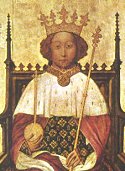Out of the fact that Richard was born at Epiphany and that three kings were present at his birth came a legend that, despite being a second son, he was destined for great things. He became heir to the throne of England, and was created Prince of Wales, when the Black Prince died suddenly in 1376. The following year his grandfather King Edward III of England also died, leaving Richard as king at the age of ten.
It was the Peasants' Revolt of 1381 that brought Richard into the limelight. His successful negotiations with the leaders of the rebellion brought the violence to an end, and he showed great promise. On reaching adulthood, however, he proved a weak, vacillating, and at the same time rather tyrannical king.
In 1382 he married Anne of Bohemia, daughter of Emperor Charles IV of Bohemia, but they had no children, and she died in 1366. In 1396 he married Princess Isabella of Valois, daughter of the king of France, and they had no children, either.
He was eventually deposed by his cousin, Henry Bolingbroke (later Henry IV), placed in Pontefract Castle, and probably murdered there in 1400. He was dead by February 17.
He was buried in King's Langley Church, Herfordshire but later moved to Westminster Abbey. His coffin was badly designed, however, and it proved easy for disrespectful visitors to place their hands in to several openings in the coffin and interfere with what was inside. It is said that a schoolboy walked off with Richard's jawbone.
See also Shakespeare's Richard II.
| Preceded by:
Edward III |
List of British Monarchs | Succeeded by:
Henry IV |
